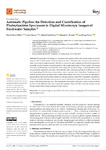Mostrar o rexistro simple do ítem
Automatic Pipeline for Detection and Classification of Phytoplankton Specimens in Digital Microscopy Images of Freshwater Samples
| dc.contributor.author | Rivas-Villar, David | |
| dc.contributor.author | Rouco, J. | |
| dc.contributor.author | Carballeira, Rafael | |
| dc.contributor.author | Penedo, Manuel | |
| dc.contributor.author | Novo Buján, Jorge | |
| dc.date.accessioned | 2022-01-20T18:06:22Z | |
| dc.date.available | 2022-01-20T18:06:22Z | |
| dc.date.issued | 2021 | |
| dc.identifier.citation | Rivas-Villar, D.; Rouco, J.; Carballeira, R.; Penedo, M.G.; Novo, J. Automatic Pipeline for Detection and Classification of Phytoplankton Specimens in Digital Microscopy Images of Freshwater Samples. Eng. Proc. 2021, 7, 9. https://doi.org/10.3390/engproc2021007009 | es_ES |
| dc.identifier.uri | http://hdl.handle.net/2183/29454 | |
| dc.description | Presented at the 4th XoveTIC Conference, A Coruña, Spain, 7–8 October 2021. | es_ES |
| dc.description.abstract | [Abstract] Phytoplankton blooming can compromise the quality of the water and its safety due to the negative effects of the toxins that some species produce. Therefore, the continuous monitoring of water sources is typically required. This task is commonly and routinely performed by specialists manually, which represents a major limitation in the quality and quantity of these studies. We present an accurate methodology to automate this task using multi-specimen images of phytoplankton which are acquired by regular microscopes. The presented fully automatic pipeline is capable of detecting and segmenting individual specimens using classic computer vision algorithms. Furthermore, the method can fuse sparse specimens and colonies when needed. Moreover, the system can differentiate genuine phytoplankton from other similar non-phytoplanktonic objects like zooplankton and detritus. These genuine phytoplankton specimens can also be classified in a target set of species, with special focus on the toxin-producing ones. The experiments demonstrate satisfactory and accurate results in each one of the different steps that compose this pipeline. Thus, this fully automatic system can aid the specialists in the routine analysis of water sources. | es_ES |
| dc.description.sponsorship | This research was funded by Consellería de Cultura, Educación e Universidade, Xunta de Galicia through the predoctoral grant contract ref. ED481A 2021/147 and Grupos de Referencia Competitiva, grant ref. ED431C 2020/24; CITIC, Centro de Investigación de Galicia ref. ED431G 2019/01, receives financial support from Consellería de Educación, Universidade e Formación Profesional, Xunta de Galicia, through the ERDF (80%) and Secretaría Xeral de Universidades (20%). | es_ES |
| dc.description.sponsorship | Xunta de Galicia; ED481A 2021/147 | es_ES |
| dc.description.sponsorship | Xunta de Galicia; ED431C 2020/24 | es_ES |
| dc.description.sponsorship | Xunta de Galicia; ED431G 2019/01 | es_ES |
| dc.language.iso | eng | es_ES |
| dc.publisher | MDPI | es_ES |
| dc.relation.uri | https://doi.org/10.3390/engproc2021007009 | es_ES |
| dc.rights | Atribución 4.0 Internacional | es_ES |
| dc.rights.uri | http://creativecommons.org/licenses/by/4.0/ | * |
| dc.subject | Microscope images | es_ES |
| dc.subject | Phytoplankton detection | es_ES |
| dc.subject | Colony merging | es_ES |
| dc.subject | Gabor filters | es_ES |
| dc.subject | Deep features | es_ES |
| dc.subject | Bag of visual words | es_ES |
| dc.title | Automatic Pipeline for Detection and Classification of Phytoplankton Specimens in Digital Microscopy Images of Freshwater Samples | es_ES |
| dc.type | info:eu-repo/semantics/conferenceObject | es_ES |
| dc.rights.access | info:eu-repo/semantics/openAccess | es_ES |
| UDC.journalTitle | Engineering Proceedings | es_ES |
| UDC.volume | 7 | es_ES |
| UDC.issue | 1 | es_ES |
| UDC.startPage | 9 | es_ES |
| dc.identifier.doi | 10.3390/engproc2021007009 |






